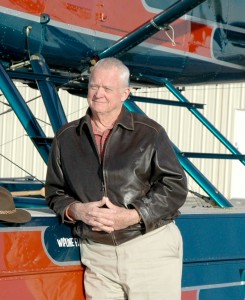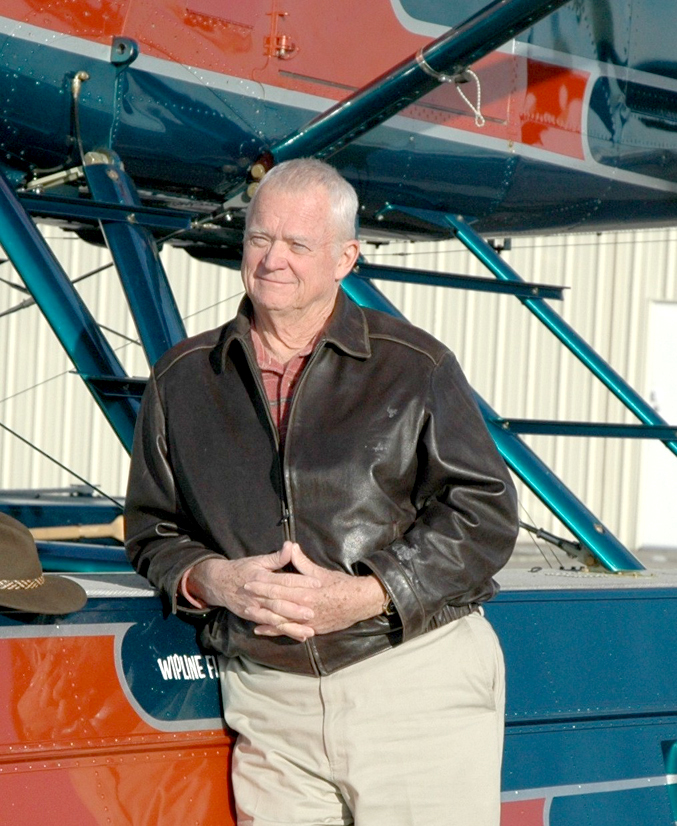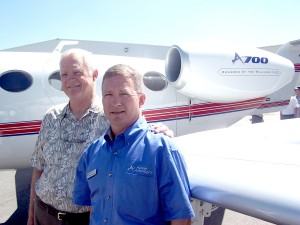By Di Freeze

Pat Wiesner, founder of Wiesner Publishing, in front of his Centennial Airport-based de Havilland Beaver.
In the early 1980s, E. Patrick Wiesner petitioned the State of Colorado to register a name for a new business venture. After some thought, he’d come up with LAMP Inc. No, he wasn’t going into the lighting business, and there wasn’t a hidden spiritual reference, but the name did hold a secret message for him.
Although he didn’t plan on telling anyone what it meant, Laugh A Minute Publishing would be a reminder to him, after previous experience, not to take himself or work too seriously ever again. But he was disappointed when he was told LAMP Inc. was already taken.
“I fell back on the next best thing I had,” he said.
Instead, he established Wiesner Publishing in Littleton, Colo. A little over two decades later, the company is the nation’s largest publisher of regional home-and-lifestyle titles, and also publishes a group of business-to-business trade magazines.
Considering his publishing background, Wiesner’s description of himself as a “physicist by education and peddler/salesman by inclination” seems odd. But digging deeper into his history explains it.
Wiesner grew up in Buffalo, N.Y., and stayed in that city to attend Canisius College, where he earned an engineering degree in 1957. In the years that followed, at a time when many were heading off to Southeast Asia, he had a critical industry deferment.
“I was working on 465L, which is the Atlas Missile program, in Chicago, as an engineer,” he said.
He worked for ITT-Kellogg briefly.
“It was probably a year or two,” he said. “They started to lose contracts, and Atlas started to phase out. All the engineers that were any good were leaving.”
Wiesner said he had a vision about the kind of work he would do as an engineer, but it didn’t work out that way.
Instead, he entered the publishing business. He began with Cahners Publishing as a technical writer and editor of Electronic Design News. “I wrote stories about electronic circuits,” he said.
Wiesner worked for Cahners for 11 years. When his boss suggested he try sales, he did, but decided he wasn’t good at it. Still, when he was told he could really make more money in that area and was encouraged to try again, he did. “Somehow, it clicked that time,” he said. “I started to understand it.
In the late-1960s, Wiesner moved to Colorado with his wife, Janet. He became interested in aviation when she bought him a $10 ride in a vintage Cessna.
“That was at old Columbine Airport,” he said. “It doesn’t exist anymore; it’s under houses now down southwest of town. I learned how to fly, and I just never quit after that.”
While selling advertising for Cahners, he acquired his first plane, a V-tail Bonanza. Initially, he utilized the aircraft while working for Cahners in Boston. He kept the Bonanza at Norwood Memorial Airport.
Then, around 1970, he moved from Boston to Seattle, when he became the director of marketing for the John Fluke Company. He worked for that company for a few years and then went to the Bay area for Cahners again to run their West Coast office, before returning to Colorado, to work for Stan Searl, who ran Cardiff Publishing.
“We published mainly cable magazines and a two-way radio magazine,” Wiesner said.
That included Communications, a magazine that covered the business and industrial land mobile radio industry. He did that for about four years, until he decided he was tired of working for somebody else, and, actually, simply tired of spending all his time “working.”
“I was really burned out,” he said. “I left that company and worked as a consultant.”
Two years later, vowing he would never allow himself to get into that “kind of pressure cooker” lifestyle again, he started Wiesner Publishing, LLC, in 1982, in a room he leased in historic Littleton, Colo., above Littleton Electric, at Littleton and Santa Fe.
“I had the office upstairs. I gave the guy a month’s rent in advance. I smoked cigars at the time. About a year later, when I left there, he wouldn’t give me my month’s rent back because he said I ruined his drapes with my cigars,” he laughingly recalled. “But he was a good landlord.”
Wiesner Publishing was started with $3,000. Initially, Wiesner went into business with Phil D. Cook and James D. Fahnestock. He owned 70 percent of the company, and his partners each owned a 15 percent share.
After buying an Apple 2E computer, Wiesner soon outlined an idea for a magazine that would become Private Cable. Since they were on a shoestring budget, he learned how to do his own circulation list, solicited articles and sold advertising.
Shortly after Private Cable was launched, Wiesner Publishing launched Mobile Radio Technology. He recalled that the first issue of MRT carried $90,000 of ad space.
“That’s what got the company moving,” he said.
Wiesner said that luck played a big part in their initial success.
“If it weren’t for luck, half the successful companies in the world wouldn’t have gotten beyond their start-up,” he said.
But, like most entrepreneurs do, Wiesner and his partners faced hurdles in their early years. He said that like other small companies that start out with a good idea, they began with a “great flourish”—and with all the answers.
“You have that flush of success,” he explained. “You think you’re invincible and bulletproof, and that you can do no wrong.”
Wiesner Publishing began acquiring more magazines, beginning with Colorado Business and The Press.
“Everything was going right, except then we bit off more than we could chew, and it started to eat us,” he said. “We had to worry about staying alive.”
In order to keep the company going, they sold MRT and Private Cable. In 1986, Intertec Publishing (now Primedia Business Magazines & Media) acquired the magazines.
The Press, which targeted the multibillion-dollar screen-printing industry, spawned Stitches, a trade publication for the commercial-embroidery industry, and ultimately, Tinta e Hilo, a Spanish-language version of both. In 1993, Wiesner sold those publications and a trade-show division for those industries to Intertec.
Wiesner Publishing’s next development phase was the homes and lifestyles market, which would eventually result in Homes & Lifestyles Publishing Company. After Wiesner bought Colorado Homes & Lifestyles Magazine, he repositioned it to include Colorado’s variable lifestyles. He added Southern Homes in 1991, renaming it Atlanta Homes and Lifestyles.
He continued to add magazines throughout the 1990s, including Wings West (later renamed Mountain Pilot). In 1994, Mountain Living was launched. After moving from the first one-room office to one on Middlefield Road, still in Littleton, Wiesner Publishing headquarters relocated to South Potomac Street, near Centennial Airport.
In 1995, the company acquired Healthcare Informatics and InfoCare, publications that targeted the fast-growing healthcare computer market. A year later, both titles were sold to The McGraw Hill Companies.
In 1996, Wiesner added to the homes and lifestyles branch with St. Louis Homes & Gardens (now St. Louis Homes & Lifestyles) and another start-up, Seattle Homes & Lifestyles. In 2000, Wiesner Publishing started Senior Market Advisor, a magazine designed to fulfill the information needs of financial service providers involved in the over-50 market. The publication of that magazine led to the advent of Senior Market Expo, an annual conference and trade show, and the Society of Senior Market Professionals, an honor society created to offer recognition to outstanding financial advisors who serve the senior market.
In 2002, the company again expanded with Variable Product Specialist magazine, dedicated to serving the leading financial planners that specialize in selling variable products. That year, a new division, Advisors Data Source, was also launched as a creative agency for the publishing business, with the plan of leveraging the power of the company’s database resources and to create custom solutions for clients, including marketing collateral, e-mail campaigns, direct mail and more. The information service division is based on a database acquired through Senior Market Advisor.
Project Publishing, a smaller division within the company, is focused on special, small-circulation publishing ventures (such as the handbook for Pope John Paul’s 1993 Denver visit and corporate newsletters).
Today, Wiesner Publishing has 144 employees and satellite offices in Atlanta, St. Louis and Seattle. Currently, the company’s business-to-business trade magazines include Colorado Biz (for which Wiesner writes a monthly column), Senior Market Advisor, Trucking Times & Sport Utility, Variable Product Specialist and Benefits Selling (launched April 2003). A recent addition to Homes & Lifestyles Publishing is Log & Timber Style.
Over the years, all of Wiesner’s six children—five sons and one daughter—worked for him at one time or other. After overseeing the company for two decades, Pat Wiesner retired from Wiesner Publishing, LLC, a few years ago. He sold the company to his son, Dan Wiesner, who is now the company’s CEO, and Laura Fallbach, who serves as executive vice president.
What now?
With more personal time on his hands since retiring, Wiesner stays active within the aviation community. Not surprisingly, he spends quite a bit of time at Centennial Airport, as does his son, Tom, who was in the Army and flew Apaches and Cobras for 13 years. Tom Wiesner now works for Centennial Airport-based Adam Aircraft.
Although the last couple years have seen a change, Wiesner remembers a decade or so ago, when the airport was “under siege by the neighborhood.” To convince surrounding communities that the airport was a good neighbor, Wiesner and Larry Ulrich (now senior vice president of the jetCenter network, but at the time president of Denver jetCenter) put together a slide presentation.
“We took it around to places like the Kiwanis Clubs,” he said.
Janet Wiesner had no idea how it would change their future when she bought her husband that first airplane ride.
“Janet’s in real estate,” he said. “She says that if she’d been able to sell me airplanes instead of houses, she would’ve been rich, because I bought so many airplanes.”
Over time, he shared interest in different planes, including a twin Aztec, before getting into vintage aircraft, after seeing a Beech 18 on the ramp, and acquiring it about 20 years ago.
“As far as I know, it was the only Twin Beech ever to be retrofitted to a tail wheel,” he recalled.
At one time he owned a Staggerwing and a T-6.
“I was one of the guys that bought all those T-6s from Africa,” he said. “I had this T-6 that I really thought was a neat airplane. I was fixing it up, getting ready to fly it, and a radiologist in Saint Louis called me up and said, ‘Do you have 7226?’ That was the number on the side of the airplane, from the South African Air Force.
“I said, ‘Yes.’ He said, ‘That’s my airplane.’ I said, ‘No, it’s my airplane.’ He said, ‘I flew that airplane in the South African Air Force.’ After talking to him for a while, I figured, ‘Geez, a guy ought to own the airplane he flew in the Air Force!’ So I sold it to him; he still has it.”
Wiesner has also owned two DC-3s. After running the first one under Part 135, he eventually sold it to a gentleman who said he wanted it for missionary work in Africa.
“As it turned out, as soon as he got his hands on it, he sold it,” Wiesner said. “All he wanted was the money.”
Later, Wiesner and Adam Aircraft founder Rick Adam put together the Rocky Mountain Aviation Foundation, and bought a DC-3 they had for several years.
“We did a lot of things with it,” Wiesner said.
That included scenic rides, training for type ratings, and unique memorials, such as scattering ashes.
“It was a great airplane. We always had this idea that we’d make money with it, but we could never get ahead of it,” he said. “Then, we gave it to The Wings Over the Rockies Museum, in the sense that Rocky Mountain Aviation Foundation’s only mission was to service the museum.”
The aircraft served as a “flying ambassador” for the museum until it was sold in autumn 2002, after it became apparent that Wings would benefit more from the cash.
Wiesner recently sold a King Air and a Citation, but he’s still half owner in a 421, with business partner Dick Hayes. In his hangar at Centennial Airport, you’ll find a beautiful de Havilland Beaver, recently outfitted with Wipline floats by Wipaire, Inc., of South St. Paul, Minn. He says that float flying is the most fun flying he’s ever done, except maybe the DC-3.
“The Beaver is a magnificent airplane,” he said. “Float flying is great.”
John Fisher, who will be moving to Hawaii this month after several years as maintenance supervisor at Centennial Airport-based C B Air, Inc., said his boss is very conscientious when it comes to flying.
“Pat is very savvy about his airplanes,” he said.
Wiesner also recently became an FBO owner. About five years ago, when he heard that Sandy Bush was buying Gunnison Valley Aviation in Gunnison, Colo., he told Bush he’d always wanted to be involved in an FBO, and asked if he wanted a junior partner.
“I didn’t know him at the time,” Wiesner said. “He said, ‘Okay.’ So I bought ten percent of that FBO with him.”
Initially, although Wiesner visited the FBO regularly, he had nothing to do with its management.
“Sandy got tired of it after a few years and I offered to buy the whole thing from him,” he said. “The problem was that there were only four years left on the lease with the county, so it wasn’t really worth anything. If you don’t have time to amortize investment, and things like that, it doesn’t make any sense.”
Wiesner and Dick Hayes bought the FBO, and made a deal with the county that if they built some hangars and made other improvements, they could get their lease out at least another 25 years.
“We’ve done all that, so it’s a really healthy little business right now,” he said.
They now have a dozen employees and are looking for other FBOs in which to invest. Wiesner is also chairman of the board of trustees of Western State College in Gunnison, and is on the Colorado Aeronautical Board, which is responsible for aviation development in Colorado. He serves as the pilot organization representative. Recent accomplishments of the board include approval of various critical AWOS stations.
He’s also heavily involved in Wings Over the Rockies. About three years ago, he became chairman of the board of directors of Aviation & Space Center of the Rockies, the museum’s governing entity.
He became involved with the museum when Carl Williams, the former chairman, asked him to be on the board. He said he had little chance of “not” being involved, since anyone that knows Williams knows it’s next to impossible to say no to him. “One thing led to another and I had the same disease he had,” he grinned.
Recently, the board made a big step into the future by selecting aviation veteran Greg Anderson for the newly created post of president and CEO of ASCOR. Anderson was brought on board to oversee the expansion of the museum to Centennial Airport and improvements at Lowry, which will result in “a world-class aviation museum and aerospace educational center.”
To read more about Wings Over the Rockies, and their exciting expansion to Centennial Airport, read “Greg Anderson: Young Eagles and Wings Expansion Top Life’s Satisfactions.”












